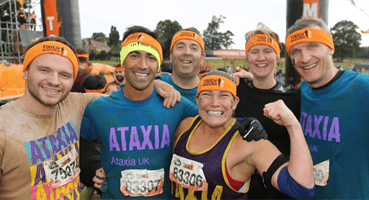On Wednesday 5th February, Ataxia UK hosted a webinar and Q&A as part of Wellbeing Week, a week from 3rd – 7th February dedicated to providing support and information to aid the wellbeing of those affected by ataxias. This webinar focused on managing symptoms in ataxias, and was presented by Dr. Michael Parkinson, Consultant Neurologist at the London Ataxia Centre, UCL Queen’s Square Institute of Neurology.
Dr. Parkinson began by giving an overview of the main ataxia symptoms, described below.
Most common ataxia symptoms
- Gait ataxia – loss of balance with unsteady, irregular, broad-based gait with swaying and risk of falls
- Limb ataxia – irregular, fragmented, tremulous movement. Problems with fine manual dexterity
- Eye movements – jerky, interrupted eye movements. Fixation may be unstable with or without blurred, double or jerky vision. Nystagmus (rapid uncontrollable movements in one or both eyes)
- Speech – slurred speech with impairment of speed and articulation
- Swallowing – food and liquid ‘going down the wrong way’, coughing and choking
He described the three main subtypes of ataxia, which are outlined below.
Main subtypes of ataxia
- Cerebellar ataxia – lack of neuropathy (nerve damage), cerebellar eye signs such as nystagmus, upper and lower limb involvement and slurred speech
- Sensory ataxia – numbness, more prominent gait or lower limb ataxia, which is worsened on rough terrain or in the dark. Examination is worse with eyes closed
- Vestibular ataxia – dizziness, vertigo, nausea. Worse with head movement
There are a number of treatable ataxias, which can be categorised by their type, as below:
Treatable ataxias by type
Autoimmune ataxias: Gluten ataxia, GAD ataxia
Vitamin deficiency-related ataxias: Vitamin E deficiency, CoQ10 (Ubiquinone) deficiency
Sensory ataxias: Vitamin B12 deficiency, Diabetic neuropathy, Alcohol-related ataxia
Episodic ataxias: Episodic ataxias 1 and 2
Metabolic ataxias: Niemann-Pick type C (NPC), Cerebrotendinous xanthomatosis, Glucose transporter 1 deficiency, Hypobetalipoproteinaemia, Hartnup disease, Biotinidase deficiency, Pyruvate dehydrogenase deficiency
See the Ataxia UK Medical Guidelines here to read about treatable ataxias. You can also read more in our Medical Guidelines about management of ataxia symptoms.
Dr. Parkinson then went on to discuss how the main ataxia symptoms can be managed.
Managing imbalance and preventing falls
There are several aids available to manage imbalance and prevent falls. These include walking aids, such as sticks, walking poles and tripod sticks. There are also frames, including two-wheeled frames and four-wheeled walkers with brakes. A wheelchair may be necessary.
When getting around, such as around the house, poles may be useful. Hoists may be useful for transferring. Additionally, home modifications including stair lifts, rails on stairs or in the bathroom, walk-in showers, wet rooms and downstairs beds may be helpful.
Support from a physiotherapist and occupational therapist might be required.
Some people may attend falls clinics, group exercise clinics or rehabilitation centres to manage imbalance and prevent falls.
Pilates courses, home exercises and use of the gym on prescription can help. The London Ataxia Centre has put together seated Pilates and strength and conditioning exercise videos specifically for people with ataxia which you can follow along with at home. Ataxia UK offers online Chair Pilates sessions led by Sonia Forde, a Pilates teacher with over 17 years of experience. Find out how you can join the sessions here.
Tremor and upper limb coordination
Medications such as Propranolol and Gabapentin may be prescribed for tremor and upper limb coordination problems. Physical aids including weighted or chunky cutlery may be used. Weighted wrist bands, and special cups with lids to prevent spills can be useful.
Physiotherapy and occupational therapy can again be helpful.
When symptoms are more severe, there has been some evidence that an intervention called Deep Brain Stimulation (DBS) can be used to manage symptoms of parkinsonism (slowness of movement, stiffness and tremors) and dystonia (involuntary muscle contractions and spasms). This involves attaching electrodes to the scalp which stimulate brain cells. There is some evidence that this can be helpful in ataxic tremor, but this needs to be researched further.
Another method available is called Transcranial Magnetic Stimulation (TMS) places an electric coil against the scalp to deliver magnetic pulses that penetrate the skull and stimulate specific areas of the brain, influencing the nerve cell activity in that area. This is a non-invasive brain stimulation procedure. Research is ongoing, and TMS is not offered yet for ataxia patients.
Spasticity and spasms
People with ataxia can show increased muscle tone and stiffness. On examination, they may present stiffness and tightness of muscles, faster than normal reflexes and involuntary and rhythmic muscle contractions known as clonus. In more severe cases, this can cause joints to become very stiff, due to tightening of muscles, tendons and skin, known as contractures. This is often associated with muscular spasms and cramps.
To help with these symptoms, stretching and Pilates are recommended. Physiotherapy is also suggested. Splinting and positioning can also help to manage these symptoms. Botox injections may be given in localised areas where the spasticity is present, to lessen the spasticity. For generalised spasticity, medications such as Baclofen, Gabapentin, Tizanidine and Dantrolene can be given. In more severe cases, surgery to lengthen the tendon may be required if other treatment options have failed.
Speech
The primary management tool for speech difficulties is speech and language therapy, so you may need to be referred to a Speech and Language Therapist if you have speech problems. People may also choose to bank their voice when they are able to speak still, which involves making a range of recordings of their speech which can then be played when they can no longer use their voice. Ataxia UK offers voice banking services to Friends of Ataxia UK via a company called SpeakUnique. There are three options: Voice Build, Voice Repair and Voice Design which will allow anyone with ataxia to have a synthetic voice that sounds how you want, no matter how badly your voice is already affected. Read more here. People may benefit from using communications aids such as text-to-voice software through programmes such as Microsoft Word or on a mobile phone app.
Swallowing
Speech and language therapy can also manage swallowing difficulties in ataxias. This can include advice on correct posture, tucking of the head, taking small mouthfuls, and avoiding foods with a consistency that can cause swallowing issues, such as very dry foods. There is a form of Botox injection that can manage spasms in the larynx that affect swallowing.
Vision
For vision difficulties, someone with ataxia may be referred to an eye specialist such as an Ophthalmologist or Optician. Prism spectacles can help with squinting and double vision. There are a number of medications available for managing nystagmus, such as Gabapentin, Baclofen and 3,4-Aminopyridine. However, not everybody may benefit from these.
Bladder problems
It is very common in ataxias for individuals to experience an urge to urinate, and they may show incomplete bladder emptying. Individuals will be tested for urinary tract infections and incomplete bladder emptying. If after going to the toilet, there is still more than 100ml of fluid left in the bladder, intermittently inserting a thin tube to empty the bladder may be suggested. If the volume of fluid left is less than 100ml, an antimuscarinic medication such as Oxybutynin, Solifenacin, Trospium or Mirabegron may be given. In some cases, people may benefit from Botox injections every six months. Percutaneous tibial nerve stimulation (PTNS) may be given, which is where impulses are sent to the tibial nerve, which controls bladder function.
Ataxia UK hosted a webinar presented by Professor Paola Giunti of the London Ataxia Centre all about managing bladder symptoms in ataxias, which you can find in our magazine here (see page 9).
Hearing
Standard hearing aids are often given in ataxias. However, this can mean that all sounds are amplified, so the person hears things they do not want to. Therefore, hearing aids with directional microphones can be provided so that the person is able to focus on hearing what they want to hear, such as the conversation they are in.
Read more about the London Ataxia Centre here.






